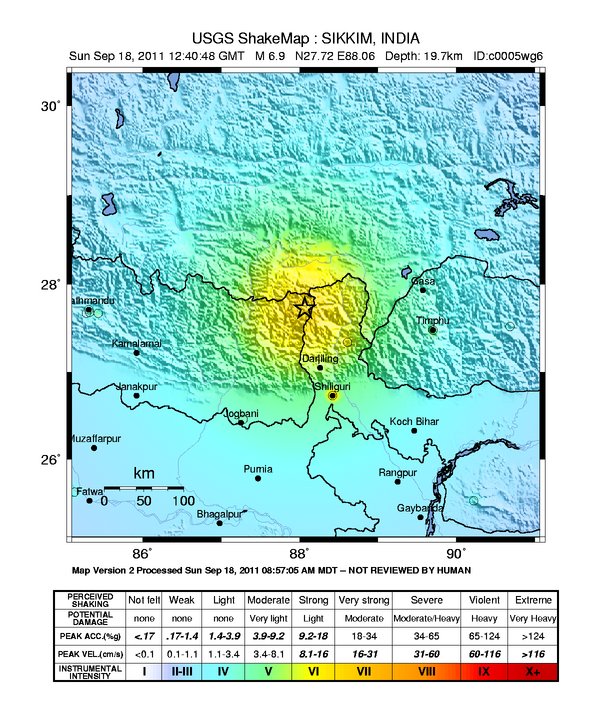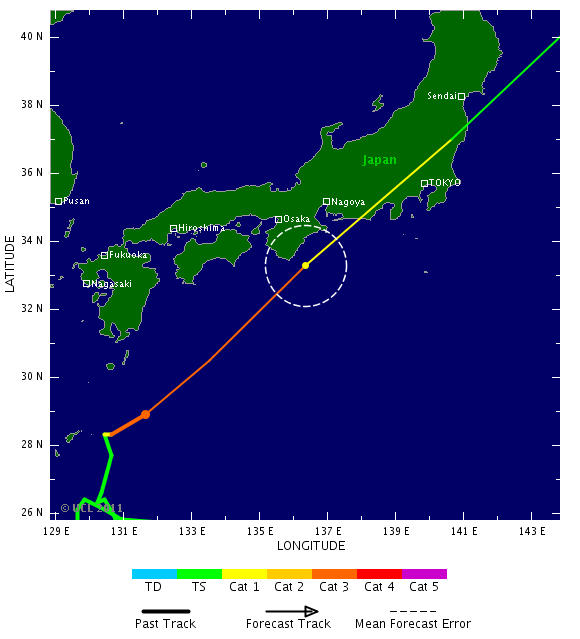20 September 2011
Update on the earthquake in the Himalayas, plus typhoon Roke, an earthquake in Guatemala and landslides in China and Italy
Posted by Dave Petley
There is a great deal going on in the world of landslides at the moment – so much so that I am struggling to keep up with the news! If you have sent me material for the blog then please accept my thanks and my apologies – I will get to it in the next few days as everything calms down. This post is a summary of the major ongoing incidents:
1. The Sikkim / Nepal earthquake
As I predicted yesterday, the death toll from Sunday’s earthquake has steadily crept upwards. Landslides remain a major problem in this emergency phase, and it is increasingly clear that they played a major role in the loss of life. An intriguing aspect of this earthquake is that there appear to have been so many landslides, even though the earthquake mechanism was essentially strike-slip (see the tectonic explanation for this event here). Generally speaking, strike slip events generate smaller numbers of landslides than do thrust events, which raises the question as to whether the major factor here was the monsoon. This would be a good PhD topic…
The latest situation that I have been able to ascertain from each country is as follows:
Nepal
Nepal News reports that 11 people were killed in this country, with the loss of life being quite spread out across the eastern part of the country. Many houses have been damaged and the Mechi Highway is apparently blocked by a landslide. It may be that information has not come through from the more isolated areas in the northeast as yet (see below), so the toll my increase a little.
Bhutan
Kuensel has a gallery of photos of the impact of the earthquake, and reports a single fatality in a landslide: “A 43-year old woman, who was on her way to fetch water, died on the spot in Lumithang village under Darla gewog, Chukha, after the earthquake last evening triggered a landslide that buried her.”
India
AFP has a report focusing on the major problems that roads blocked by landslides are causing to the relief effort. The reported death toll appears to be 41 people in Sikkim, plus nine in West Bengal and six in Bihar, giving a total on 56 in India, though again this total is likely to creep upwards over the next 24 hours. Kangla Online carries a report of an additional eight deaths in a bus that was caught in a landslide in North District.
Tibet
Xinhua reports seven deaths and 22 people injured in Yadong County in Tibet, with a large numbers of landslides and 70% of houses in the county having been damaged.
As an aside, the USGS shakemap, which should be seen as just a first order estimation of the potential impact, highlights two things:
 First, the epicentre is in Nepal and not India, so we should not be calling this the Sikkim earthquake. Actually, this is Tapeljung district of Nepal, so the Tapeljung earthquake would be a more accurate name. Second, as large an area of Nepal as of India should have been affected by strong shaking – so the apparently lower level of loss in Nepal is probably a consequence smaller number of people in this area. However, it is likely that conditions are very serious for those living in that area.
First, the epicentre is in Nepal and not India, so we should not be calling this the Sikkim earthquake. Actually, this is Tapeljung district of Nepal, so the Tapeljung earthquake would be a more accurate name. Second, as large an area of Nepal as of India should have been affected by strong shaking – so the apparently lower level of loss in Nepal is probably a consequence smaller number of people in this area. However, it is likely that conditions are very serious for those living in that area.
2. Typhoon Roke
Meanwhile, Japan is preparing for a direct hit from typhoon Roke, which is following a somewhat unpredictable course northwards and should reach the southern part of the country in the next 24 hours (map from Tropical Storm Risk):
The storm is already bringing heavy rainfall across much of southern Japan. Meanwhile (and thanks once again to Colin Stark for his help with information about this situation), efforts continue to monitor and mitigate the landslide dams created by Typhoon Talas in late August – and of course the heavy rainfall from Roke may exacerbate that situation considerably. This pdf document provides an overview of two of the landslide dams (In Japanese, but easily translated with Google translate). There is also a wonderful information page about these dams online here (also in Japanese, but again easily translatable with Google translate). This includes real-time monitoring data of the water level on four of the dams.
Once again, the Japanese are showing the way in terms of managing landslide problems. If only a similar approach had been taken at Attabad.
3. Earthquakes in Guatemala
Meanwhile, Guatemala yesterday suffered four earthquakes in a 150 minute period, the largest of which had a magnitude of 5.8 according to the USGS. Reports suggest that two people were killed in their cars by a landslide.
4. Landslides in China
China has also suffered a spate of heavy rainfall, which is ongoing, in this late monsoon period. The most serious incident was a landslide in Baqiao, a suburb of Xi’an in Shaanxi Province, when a landslide with a volume of 100,000 cubic metres buried a number of small workshops, killing 32 people (of which 17 bodies have been recovered). Xinhua has a dramatic image of the landslide:
This looks to be a slide in loess. The site is clearly a quarry, so there may be a strong human element to the causation of the landslide.
There have been other landslides too – for example, Xinhua reports that three people were killed in a landslide in Chaoyu Township in Weibin District, Baoji this morning.
5. Two killed in a landslide in Italy
Finally, two hikers were reportedly killed on Sunday by a landslide to the south of Aosta in the Alps.




 Dave Petley is the Vice-Chancellor of the University of Hull in the United Kingdom. His blog provides commentary and analysis of landslide events occurring worldwide, including the landslides themselves, latest research, and conferences and meetings.
Dave Petley is the Vice-Chancellor of the University of Hull in the United Kingdom. His blog provides commentary and analysis of landslide events occurring worldwide, including the landslides themselves, latest research, and conferences and meetings.
Photographs and reports on damage around Gangtok on the Sikkim NOW! Blog http://sikkimnow.blogspot.com/
[…] As expected, the death toll from the Tapeljung (Nepal) earthquake continued to rise yesterday. Latest reports suggest that 61 people died in Sikkim, plus 12 in West Bengal, nine in Bihar, 11 in Nepal and seven in Tibet, generating a total of 91 deaths so far. However, AP is now reporting that there are fears that a landslide buried a further 40 people at a construction site for a hydroelectric plant at the town of Saffo on the Teesta River. Presumably this is the project described in this website – it will be interesting to see how this story develops. It is unclear to me at the moment whether the reported death toll for Sikkim includes the 12 workers known to have died at the site. […]